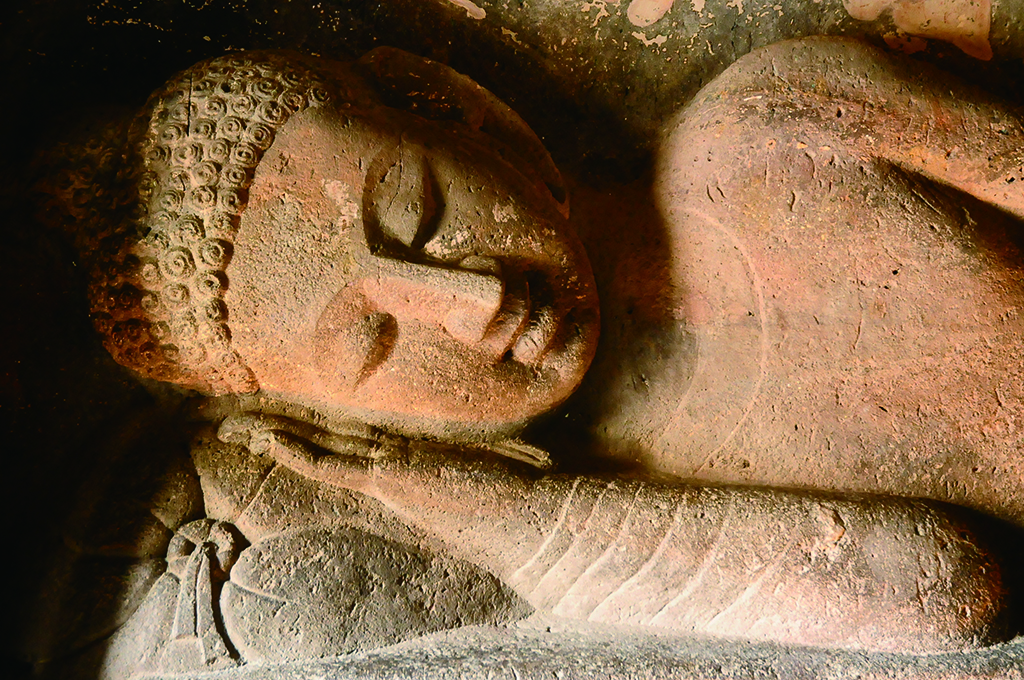Special Topics
Remaining Steadfast in the Face of Aging, Illness and Death
 In the sutras, the Buddha reminds us that the length of a person's life is actually the interval between an exhalation and inhalation, and death follows us like our shadow. We should constantly reflect and remain aware on this, while making the most of our human form by practicing diligently in order to escape from the vast samsaric ocean of birth and death.
In the sutras, the Buddha reminds us that the length of a person's life is actually the interval between an exhalation and inhalation, and death follows us like our shadow. We should constantly reflect and remain aware on this, while making the most of our human form by practicing diligently in order to escape from the vast samsaric ocean of birth and death.In the face of aging, sickness and death, what level are you as a practitioner?
Matters of life and death are critical, unpredictable, and ever-present. How alert and aware are you, when learning the news of aging, sickness, and death? In Sutra 922 of the Saṃyukta-āgama, the Buddha used the metaphor of four types of excellent horses to illustrate the attitudes of four kinds of good men who possess varying spiritual capacities when facing impermanence.
At the time, in the Kalanda Bamboo Garden in Rajagaha, the Buddha told the monks that there are four types of thoroughbred horses (assājānīya) to be found in the world. The first type—the excellent horse—can understand its master's intention upon seeing the shadow of its owner's goad-stick. Good at observing the driver, it is able to run at its master's will, whether running fast or slow, left or right. This is the best type of horse in the world.
The second type of horse is unable to immediately become alert and aware upon seeing the shadow of the goad-stick. Therefore, it has to wait until the stick touches and reaches its coat hair (loma) to realize its master's intention and gallop forward according to the master's instructions.
The third type of good horse is unable to become alert to and aware of its master's intentions when seeing the shadow of the goad-stick. When the stick reaches and touches its coat hair, it has to wait until the stick strikes and pricks its hide (camma) to become alert and aware of it, after which it will follow its owner's instructions and gallop forward.
The fourth type of good horse is unable to immediately become aware upon seeing the shadow of the goad-stick, or when the stick touches its coat or strikes its hide. It has to wait until the iron goad stabs its body, pierces its hide, and hurts into its bone marrow, to be willing to run forward according to its master's instructions.
Four types of good horses as a metaphor for four kinds of good men
Similarly, there are four types of good men who practice the Dharma and uphold the precepts. The primary type of good man can arouse fear as soon as he hears that someone is suffering from illness, as well as death, and knows how to think rationally according to the truth and tame his mind. This is analogous to first type of good horse: willing to receive training on seeing the shadow of a goad-stick.
The second type of good man knows no fear and does not understand how to think correctly until he sees others suffering from illness or death. This is analogous to the second type of good horse, who will only be willing to gallop forward according to the owner's will when its coat is touched by a goad-stick.
The third kind of good man knows no fear and does not understand how to think rationally until a good teacher or his relatives and friends encounter illness or death. This is analogous to the third type of good horse, who will be stricken to the hide by a goad-stick before it knows to follow its master's will and run forward.
The last kind of good man cannot generate fear on hearing or seeing others' suffering from old age, illness, or death. He has to wait until he faces illness or death before he can generate the mind of renunciation and fright, and know how to think rationally according to the truth, just as the fourth type of good horse will not know how to run forward according to the master's will until an iron goad pricks their body and penetrates into their bones.
Make the most of our human form to diligently engage in practice
In Sutra 922 of the Saṃyukta-āgama, the Buddha used the parable of a horse of good breed to emphasize the awareness and knowledge of suffering. The four types of good horses, though differing in the level of their awareness, at least all understand the need to deal with suffering and, thus, are all "good horses" prone to training. Having learned the Buddha's teaching in addition to witnessing and hearing how aging, illness, and death are both constantly happening around us and affecting us personally, —and we may be personally suffering we should remind ourselves to generate a fearful mentality toward aging, illness, and death. We can then seize the time to diligently engage in practice, by eliminating evil and cultivating good deeds, so as to cross the samsaric stream of birth and death.
The Buddha was a prince before leaving the household life. Having witnessed old age, the sick, and the dead while traveling around the four city gates, he aroused the mind of fear and renunciation, firmly pursuing the Path through diligent practice, until he finally attained ultimate enlightenment. He was the most superior practitioner. So, what level of practitioners are we ourselves?
The starting point for reflecting on death
 "The day has passed, and my life has thus also diminished. Like fish running out of water, what joy is there? You should work hard, like saving your head from burning, but your mind is impermanent, so be wary of idleness." As part of the daily evening chanting at Buddhist temples, this "Bodhisattva Samantabhadra's Verse of Admonition" +reminds us that one day has passed, and our life span has also been shortened. Life is like stone, fire and lightning, and the unpredictable fire can burn our heads at any time.
"The day has passed, and my life has thus also diminished. Like fish running out of water, what joy is there? You should work hard, like saving your head from burning, but your mind is impermanent, so be wary of idleness." As part of the daily evening chanting at Buddhist temples, this "Bodhisattva Samantabhadra's Verse of Admonition" +reminds us that one day has passed, and our life span has also been shortened. Life is like stone, fire and lightning, and the unpredictable fire can burn our heads at any time.When we constantly contemplate the impermanence of life, always be prepared for the death that may happen to us at any time, visualize that there is only one breath left in our life, and urge ourselves to make good use of our limited life to uplift ourselves and do good, and we will not worry about death when it really comes.
Related articles:
Making a Will in Advance and Facing Death Head-On
The Buddha's demonstration of his final journey
The Buddha Teaches You to Say Goodbye Properly
Contemplating death with a remembrance of impermanence
Remaining Steadfast in the Face of Aging, Illness and Death
Resource: Issue 468 of Humanity Magazine, Dharma Drum Publishing Corporation
Translation: Christina
Editing: Keith Brown, Chiacheng Chang (張家誠)
